Combining rests
In this guide...
Key terms:
Subscription required!
To view the complete study guide, you will need a valid subscription. Why not subscribe now?
Already have a subscription? Make sure you login first!
Introduction
Now that we have met nearly every type of time signature and every kind of note, rest, dot, and tie, let's look at one of the more tricky aspects of writing music correctly: how to combine rests together.
Add the missing rests
In your music theory exam, you will be required to add the appropriate rests to a passage of music with a time signature and note values. We obviously have to make sure that the bar adds up! We can't have 4/4 bars with only three crotchets worth of notes and rests!
But we can do more than just have the correct total values. We are always aiming to make the notation of our music as clear as possible. A few simple rules for which rest types to use where help us to do this.
Just like with the note groups and beams, we want rest values to help show how the bar divides into beats and other regular units. Whatever the space, we use rests to add up to the next unit value.
For instance, consider the rather odd example below:
 One note and a bar full of rests
One note and a bar full of restsA single semiquaver at the start is the only note in the bar. Our first rest is another semiquaver value, which adds up with the semiquaver note to make a quaver unit. To this we add a quaver rest to complete the crotchet beat unit, and a crotchet rest to to complete the minim (half bar) unit, and finally a minim rest to complete the bar (semibreve unit).
In summary:
- Write a rest next to the note to make the note plus rest add up to the next unit value (e.g., semiquaver plus semiquaver to make a quaver)
- Write a second rest to the right of the first rest, to make the total add up to the next unit value (e.g., quaver plus [semiquaver + semiquaver] to make a crotchet)
- Do this yet again, adding another rest to add up to the next unit value (e.g., crotchet plus the crotchet's-worth we already have to make a minim)
- Keep doing this until the available space is filled (e.g., add a minim to the minim's-worth we already have to make a semibreve, which would fill the bar in 4/4)
Here is the same example in the form of a question with an answer to show the working:
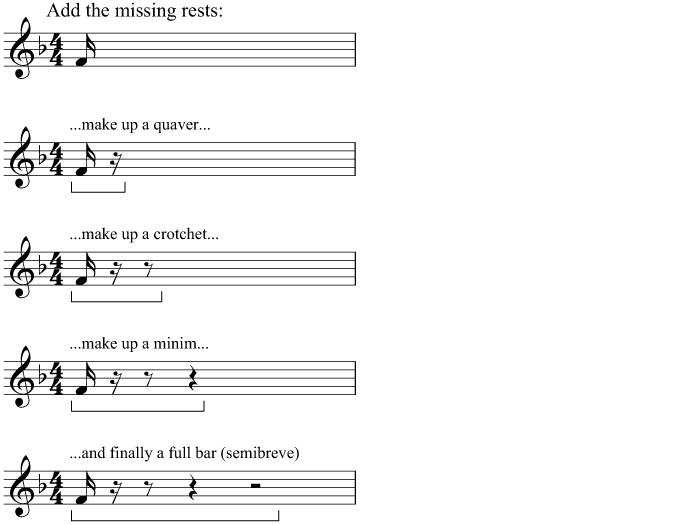 Q. Add the missing rests (method 1)
Q. Add the missing rests (method 1)Another way to think
You may prefer to think of this another way:
- Mark out where the beats are, based on the time signature
- Start with the largest single rest value that would fit in the space and put this on the right (a minim rest in the example above).
- After this, you use the next largest value that fits and put this to the left of that first, biggest rest (the crotchet rest here).
- You continue this process until the bar is filled up.
Here is an example question and an answer that shows this working:
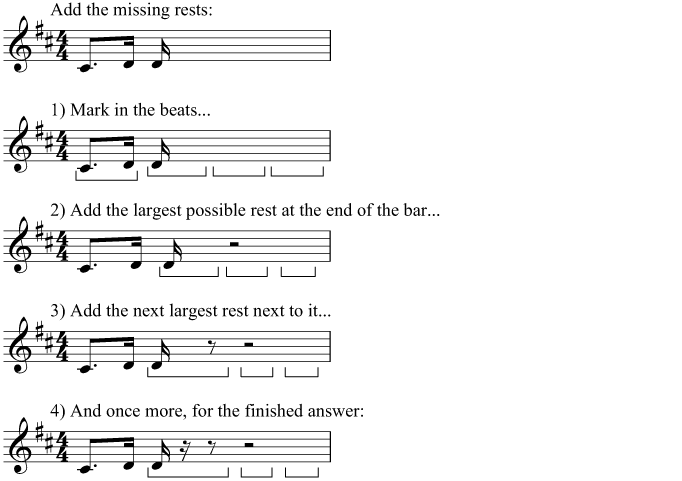 Q. Add the missing rests (method 2)
Q. Add the missing rests (method 2)Combining rests
This system works whatever the note values and wherever they occur.
However! We must always aim to make the beat units clear. Therefore, if the note appears at the end of the bar, our biggest rests start on the left of the space we need to fill.
In the example below - the opening of Mozart's opera The Magic Flute - there is a semiquaver at the very end of the bar. Therefore, our biggest rest value (a crotchet) fills the third beat, coming before the shorter value(s).
Our rules say that the remaining span should be filled with a quaver rest followed by a semiquaver rest. However, as we know, we can use dots to simplify this notation:
 Rests in the opening of Mozart's The Magic Flute
Rests in the opening of Mozart's The Magic FluteWarning!
Warning! We can use dots where the shorter value follows the longer one within a beat span, but we do not use dots if the shorter value comes first. We would not use dotted rests in the first example:
 Q. Add the missing rests (incorrect answer!)
Q. Add the missing rests (incorrect answer!)Dotted rests
"We can use dots where the shorter value follows the longer one within a beat span, but we do not use dots if the shorter value comes first."
This rule about using dots is also true if a dotted rest would be the only rest in a bar: the dotted rest must not follow a note shorter than the dotted rest.
We can construct this situation by considering a single crotchet at the beginning or at the end of a bar. As shown here, we must not use a dotted rest to fill up the remaining rests:
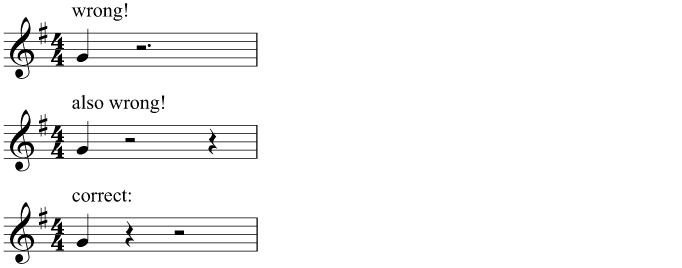 A single crotchet at the beginning of a bar must not be preceded by a dotted rest
A single crotchet at the beginning of a bar must not be preceded by a dotted restYou can perhaps understand why this rule exists by looking at the second bar in that example, marked
However if the single crotchet were at the end of the bar, we could use a dotted rest, because the dotted rest does not come after a shorter value:
 A single crotchet at the beginning of a bar can be followed by a dotted rest
A single crotchet at the beginning of a bar can be followed by a dotted restIt is never compulsory to use dotted rests, but they can make music easier to read if this rule is followed. They are not always clearer, however, as is shown in the "but clearer" bar above.
Compound time signatures
We can use the same process for the 3-unit beats used in compound time signatures. For example, if we had just one semiquaver at the start of a 6/8 bar, the rests would look like this:
 Rests in compound time
Rests in compound timeNotice in the above example that we do not use a crotchet rest within the dotted crotchet beat of a compound time signature. This is because the dotted crotchet divides equally into three quavers, not into one crotchet and one quaver (which would be an unequal subdivision).
Again, we can use either of our two methods to achieve this.
Following the first method, starting with just a semiquaver note at the start of a bar of 6/8, we would add the remaining rests as follows:
- Add a semiquaver rest to the semiquaver note to make up a whole quaver (two semiquavers make up a quaver)
- Add two quaver rests to make up the first dotted crotchet beat (three quavers make up a >dotted crotchet)
- Add the dotted crotchet rest to complete the bar (two dotted crotchets make a complete 6/8 bar)
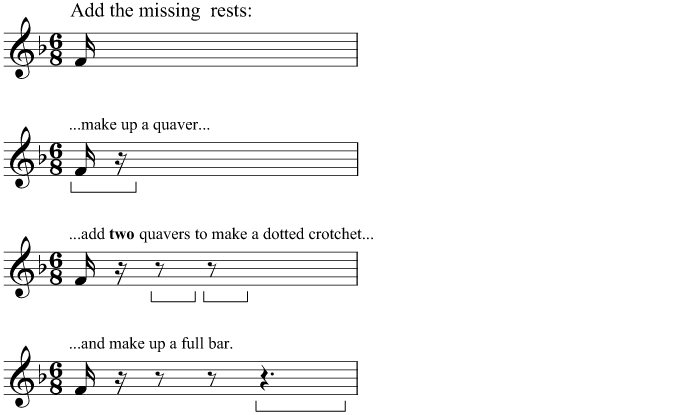 Adding rests in compound time, first method
Adding rests in compound time, first methodUsing the second method:
- Mark in the beats (here we have to mark in quaver beats)
- Add the longest possible rest on the right (a dotted crotchet rest)
- Add the next longest possible rest. Here the next longest rest type is a quaver and we can add two in the remaining space. A crotchet would not be correct.
- Add the next longest possible rest: a semiquaver to complete the first quaver, and the whole bar.
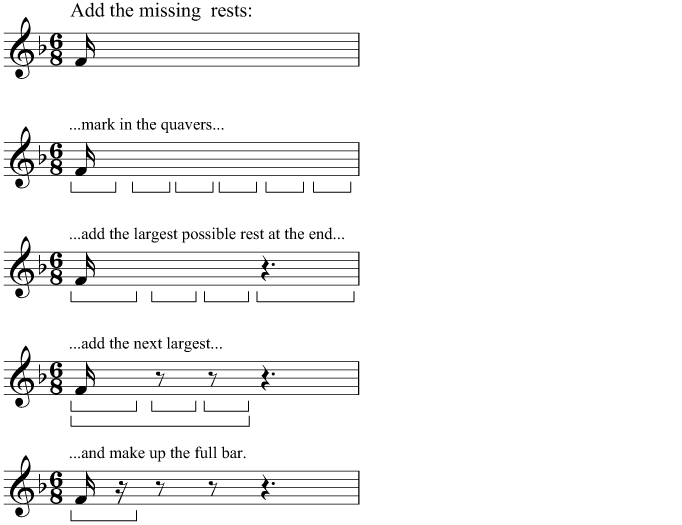 Adding rests in compound time, second method
Adding rests in compound time, second methodTriplets
Remember that we also have beats dividing in three parts (rather than two) when we use triplets. All of the same rules for combining rests in compound time signatures apply here too, and we only use the unit that is being tripled.
For instance, look at the example below. Notice that at the start of the second bar there is a beat with only one triplet quaver note in it. We use two quaver rests to complete this beat, not a crotchet, because quavers are being "tripled": three quavers in the time of two.
 Rests within triplets
Rests within tripletsA rule for notes
The rule for rests is not applied to notes, however, as you can see in the 2nd beat of the 2nd bar in the example above: we have a crotchet F within the triplet quaver, rather than two quaver F's tied together.
This is because the beaming rules would cause the two tied F's to also share a beam, and we never tie notes that are beamed unless otherwise unavoidable.
Here is the same example again showing how this would look:
 Never tie beamed notes!
Never tie beamed notes!This is never a problem with rests, as they are, of course, never tied or beamed.
Read more...
With a subscription to Clements Theory you'll be able to read this and dozens of other study guides, along with thousands of practice questions and more! Why not subscribe now?
Revision
Are you sure you've understood everything in this study guide? Why not try the following practice questions, just to be sure!